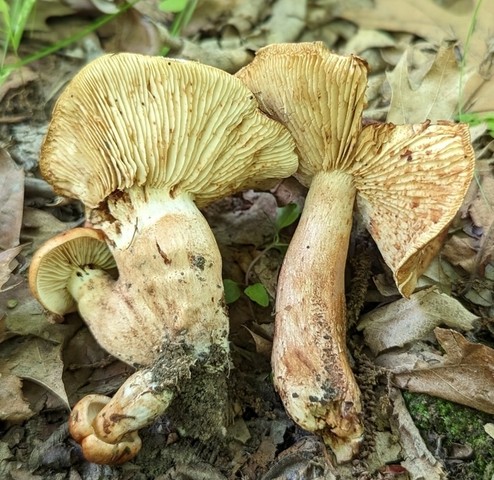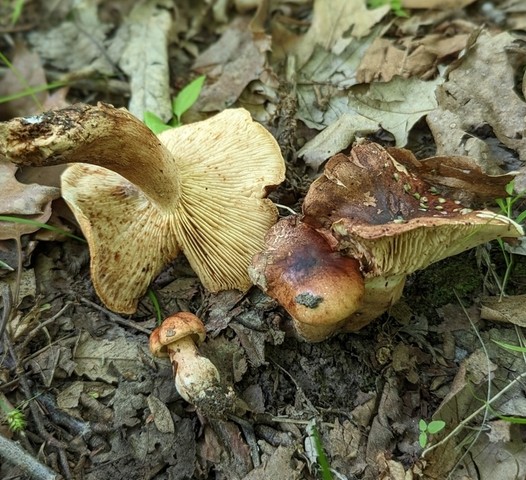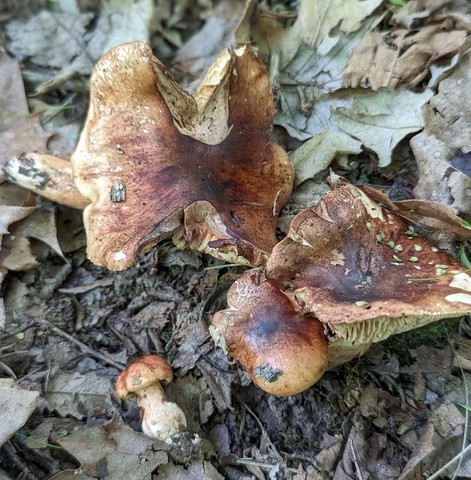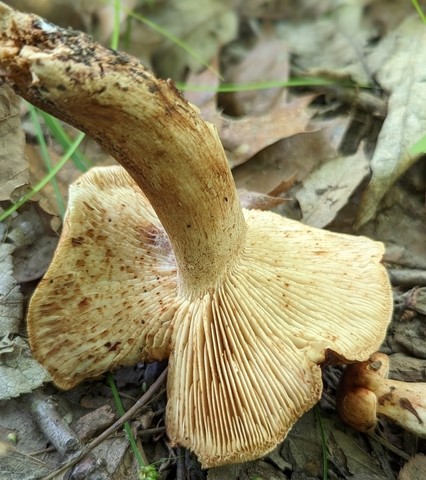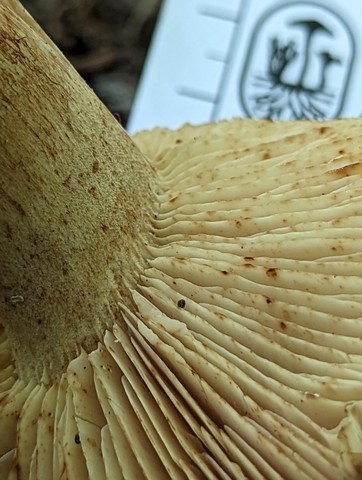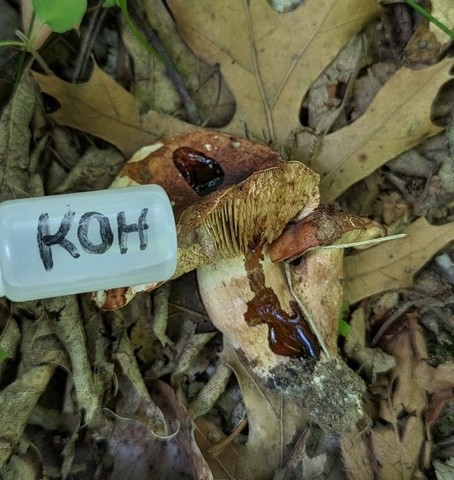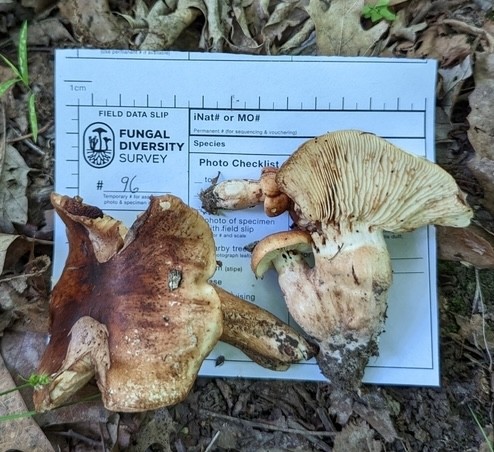White-Banded Bitter Knight
Tricholoma amarissimum
Life > Fungi > Basidiomycota > Agaricomycotina > Agaricomycetes > Agaricomycetidae > Agaricales > Tricholomataceae > Tricholoma > Genuina
Description
The White-Banded Bitter Knight (Tricholoma amarissimum) is a mycorrhizal mushroom that associates with Oak (especially Red Oak) and can be found from July to early November. It grows alone or in clusters from the soil in Oak woodlands. Its range extends from eastern Nebraska eastward to New York and Montreal.
Tricholoma amarissimum is a gilled mushroom with an orange-brown cap that is viscid or tacky to the touch when moist. Leaf debris often sticks to the cap surface as it dries. The gills are notched at the point of attachment to the stem (emarginate), white or orange-white in color, and bruise orange-brown. The stem is fibrous and distinctly colored, with a white band at the apex, in contrast to the orange-brown coloring below. It has a mealy (farinaceous) odor and a strongly bitter taste.
The scientific name amarissimum comes from the Latin root amar (‘bitter’) combined with -issimum (‘to the highest degree’), referring to its extreme bitterness. The name suggests that this is the most bitter Tricholoma (Donald J. Borror, 1988).
The key features for this species are:
- The orange-brown viscid cap
- Notched gills
- A bitter taste
- The clearly delimited white band at the apex of the stipe
- Association with oak from July to early November
This species is not known to be edible, and most Tricholomas should not be eaten due to known toxicity in the genus (Beug, n.d.).
Observations
June 13th, 2023 Indian Cave State Park
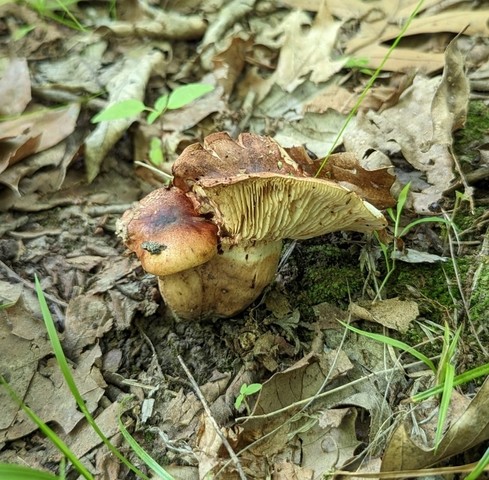
96
Growing gregariously to clustered from soil on oak/hickory woodland ridge near American Hophornbeam, Northern Red Oak, Hackberry and elm trees. Taste and smelled like cucumber.
- Gills are notched.
- Stipe thick and fibrous.
- Smell: farinaceous.
AACTTGGTCATTTAGAGGAAGTAAAAGTCGTAACAAGGTTTCCGTAGGTGAACCTGCGGAAGGATCATTATTGAATAAGCTTGGTTGGGTTGTTGCTGGCTCCTCGGGGCATGTGCACGTCCAACACCAATCTTTTACCACCTGTGCACCTTTTGTAGACCTGGATATCTCTCGAGGAAACTCGGTATGGGGACTGCTGAGTGTCAAAGCCAGCTTTCCTTACATTTCCGGTCTATGTCTTTATATATACACCATTAGTATGTCTATGAATGTTAATTATCGGACTTGACTGTCCAATAAAACCTTATACAACTTTCAACAACGGATCTCTTGGCTCTCGCATCGATGAAGAACGCAGCGAAATGCGATAAGTAATGTGAATTGCAGAATTCAGTGAATCATCGAATCTTTGAACGCACCTTGCGCTCCTTGGTATTCCGAGGAGCATGCCTGTTTGAGTGTCATGAAATTCTCAACCTTTTTGGCTTTTTTACCAAGTCGATTAGGCTTGGATATGGGAGTTTGCGGGCTTCTCTGAAGTCGGCTCTCCTTAAATTCATTAGTAGGGACCTCTTGTTGCCTTAGCTTTTGGTGTGATAATTATCTACGCCATCATGTGAAGCAGCTTTAAATTGGGGGTTACTGCTCTCTAACCGTCTCCTTGGTGGGACAATTTATGACAATTTGACCTCAAATCAGGTAGGACTACCCGCTGAACTTAAGCATATCAATAAGCGGAGGAAAAGAAACTAACAAGGATTCCCCTAGTAACTGCGAGTG
References
Beug, M. (n.d.). Mushroom Poisoning Syndromes. North American Mycological Association. https://namyco.org/interests/toxicology/mushroom-poisoning-syndromes/
Donald J. Borror. (1988). Dictionary of Word Roots and Combining Forms Compiled from the Greek, Latin, and Other Languages. Mayfield Publishing Company. https://www.penguinprof.com/uploads/8/4/3/1/8431323/dictionary_of_word_roots_and_combining_forms.pdf
Renée Lebeuf, Jacques Landry, Irja Saar, Stephen D. Russell, and Clark L. Ovrebo. 2024. New species of Tricholoma in sections Genuina and Fucata from eastern North America. Botany. 102(10): 395-420. https://doi.org/10.1139/cjb-2024-0057
Created December 15, 2025 at 10:41 AM
